Papers by Andrew Jorgenson

American Sociological Review, 2023
Building on cornerstone traditions in historical sociology, as well as work in environmental soci... more Building on cornerstone traditions in historical sociology, as well as work in environmental sociology and political-economic sociology, we theorize and investigate with moderation analysis how and why national militaries shape the effect of economic growth on carbon pollution. Militaries exert a substantial influence on the production and consumption patterns of economies, and the environmental demands required to support their evolving infrastructure. As far-reaching and distinct characteristics of contemporary militarization, we suggest that both the size and capital intensiveness of the world’s militaries enlarge the effect of economic growth on nations’ carbon emissions. In particular, we posit that each increases the extent to which the other amplifies the effect of economic growth on carbon pollution. To test our arguments, we estimate longitudinal models of emissions for 106 nations from 1990 to 2016. Across various model specifications, robustness checks, a range of sensitivity analyses, and counterfactual analysis, the findings consistently support our propositions. Beyond advancing the environment and economic growth literature in sociology, this study makes significant contributions to sociological research on climate change and the climate crisis, and it underscores the importance of considering the military in scholarship across the discipline.

Environmental Research Letters
This study advances research at the intersection of environmental degradation, social stratificat... more This study advances research at the intersection of environmental degradation, social stratification, and population health in the United States. Expanding the theoretical principles of Power, Proximity, and Physiology, we hypothesize that the harmful effect of fine particulate matter on life expectancy is greater in states with higher levels of income inequality and larger black populations. To test our hypothesis, we use two-way fixed effects regression analysis to estimate the effect of a three-way interaction between fine particulate matter, income share of the top ten percent, and the percent of the population that is black on state-level average life expectancy for all US states and the District of Columbia (2000-2014). The findings support our hypothesis: the estimated effect of the three-way interaction on average life expectancy is negative and statistically significant, net of various socioeconomic and demographic controls. Using post-estimation techniques, we visually illustrate that the harmful effect of fine particulate matter on life expectancy is especially pronounced in states with both very high levels of income inequality and very large black populations. We conclude by summarizing the theoretical and substantive implications of our findings, the limitations of the study, and potential next steps in this evolving area of interdisciplinary research.
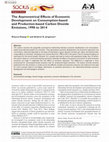
Socius: Sociological Research for a Dynamic World
The authors examine the potentially asymmetrical relationship between economic development and co... more The authors examine the potentially asymmetrical relationship between economic development and consumption-based and production-based CO2 emissions. They decompose economic development into economic expansions and contractions, measured separately as increases and decreases in gross domestic product per capita, and examine their unique effects on emissions. Analyzing cross-national data from 1990 to 2014, the authors find no statistical evidence of asymmetry for the overall sample. However, for a sample restricted to nations with populations larger than 10 million, the authors observe a contraction-leaning asymmetry whereby the effects of economic contraction on both emissions outcomes are larger in magnitude than the effects of economic expansion. This difference in magnitude is more pronounced for consumption-based emissions than for production-based emissions. The authors provide tentative explanations for the variations in results across the different samples and emissions measu...
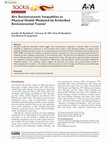
Socius: Sociological Research for a Dynamic World
Although established theoretical models suggest that socioeconomic inequalities in physical healt... more Although established theoretical models suggest that socioeconomic inequalities in physical health are partially mediated or explained by exposures to environmental toxins, there is little empirical evidence to support these processes. Building on previous research, we analyze data from the National Health and Nutrition Examination Surveys (2007–2008) to formally test whether associations between socioeconomic status and self-rated physical health are mediated by direct biological assessments of environmental toxins. We find that the embodiment of environmental toxins is disproportionate in individuals of lower socioeconomic status. Although toxins in general and lead in particular are unrelated to self-rated health, socioeconomic differences in self-rated physical health are partially mediated by embodied cadmium. Our mediation analyses suggest that education and income may promote physical health by reducing exposures to cadmium. This study contributes to previous work by bridging...

Energy Research & Social Science
We investigate the political economy of Renewable Portfolio Standard (RPS) adoption, the most com... more We investigate the political economy of Renewable Portfolio Standard (RPS) adoption, the most commonly used policy tool by U.S. states to curb greenhouse gas emissions. A growing body of research examines the drivers of RPS adoption, but this work has given scant attention to the ways in which the fossil fuel industry potentially moderates the effects of the other drivers of adoption. Therefore, we use discrete-time logistic regression analysis to estimate models of RPS adoption that include an interaction between fossil fuel production levels, and a commonly observed driver of adoption — state government ideology. We find that conservative, moderate, and liberal state governments are likely to adopt an RPS in states with no fossil fuel production. However, only moderate and liberal governments are likely to adopt in major fossil fuel producing states.

Sociological Theory
For years, sociologists who study society and the environment have focused on resolving the debat... more For years, sociologists who study society and the environment have focused on resolving the debate regarding the relationship between economic development and environmental degradation. Studies from a family of critical perspectives tend to find that economic development is antithetical to environmental protection, whereas a suite of more optimistic perspectives has uncovered more hopeful findings. We attempt to resolve these differences by situating this debate within the larger framework of the anthro-shift. The anthro-shift explains how the society-environment relationship changes over time. The theory assumes this relationship is the product of interrelations among the state, market, and civil society sectors. We focus on two distinctive qualities of the anthro-shift: the role risk plays as a pivot for reorienting how society interacts with the natural environment and the multidirectionality of the theory, highlighting how it combines elements of many of the dominant critical an...
International Journal of Sociology and Social Policy
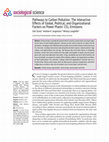
Sociological Science
Climate change is arguably the greatest threat to society as power plants, the single largest hum... more Climate change is arguably the greatest threat to society as power plants, the single largest human source of heat-trapping pollution, continue to emit massive amounts of carbon into the atmosphere. Sociologists have identified several possible structural determinants of electricity-based CO 2 emissions, including international trade and global normative regimes, national political-legal systems, and organizational size and age. But because they treat these factors as competing predictors, scholars have yet to examine how they might work together to explain why some power plants emit vastly more pollutants than others. Using a worldwide data set of utility facilities and fuzzy-set methods, we analyze the conjoint effects of global, political, and organizational conditions on fossil-fueled plants' CO 2 emissions. Findings reveal that hyperpolluters' emission rates are a function of four distinct causal recipes, which we label coercive, quiescent, expropriative, and inertial configurations, and these same sets of conditions also increase plants' emission levels.
Ekonomika
We assess the relationship between national-level income inequality and carbon dioxide emissions ... more We assess the relationship between national-level income inequality and carbon dioxide emissions for a sample of eleven post-Soviet nations during the 1992 to 2009 period. Our findings suggest that both total and per capita emissions are positively associated with income inequality, measured as a Gini coefficient. These results are consistent with analytical perspectives that highlight how income inequality could lead to increases in carbon emissions as well as recent sociological research on income inequality and emissions for samples of nations in other structural and geographical contexts.
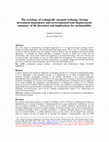
Journal of Political Ecology
The article begins by summarizing sociological approaches to (1) ecologically unequal exchange, a... more The article begins by summarizing sociological approaches to (1) ecologically unequal exchange, and (2) foreign investment dependence and environmental load displacement. These areas of sociological inquiry consist of structural theories and cross-national statistical analyses that test hypotheses derived from both approaches. It concludes by briefly describing sociological research on global civil society and the environment, with a focus on the world society approach to environmental change. This area of theory and research provides some insights on ways in which global and transnational civil society groups, such as environmental international nongovernmental organizations, can partially mitigate the environmental harms caused by ecologically unequal exchanges and environmental load displacements.Key words: ecologically unequal exchange, environmental load displacement, foreign investment dependence
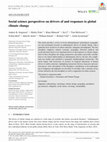
Wiley Interdisciplinary Reviews: Climate Change
This article provides a review of recent anthropological, archeological, geographical, and sociol... more This article provides a review of recent anthropological, archeological, geographical, and sociological research on anthropogenic drivers of climate change, with a particular focus on drivers of carbon emissions, mitigation and adaptation. The four disciplines emphasize cultural, economic, geographic, historical, political, and social-structural factors to be important drivers of and responses to climate change. Each of these disciplines has unique perspectives and makes noteworthy contributions to our shared understanding of anthropogenic drivers, but they also complement one another and contribute to integrated, multidisciplinary frameworks. The article begins with discussions of research on temporal dimensions of human drivers of carbon emissions, highlighting interactions between long-term and nearterm drivers. Next, descriptions of the disciplines' contributions to the understanding of mitigation and adaptation are provided. It concludes with a summary of key lessons offered by the four disciplines as well as suggestions for future research.
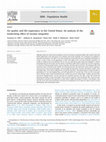
SSM - Population Health
Although studies have shown that air pollution can be devastating to population health, little is... more Although studies have shown that air pollution can be devastating to population health, little is known about the health implications of the intersection of air pollution and income inequality. We investigate if air pollution is especially detrimental to the health of US state populations characterized by more inequitable distributions of income. In other words, are the populations of states with higher levels of income inequality especially vulnerable to similar levels of air pollution? We use two-way fixed-effects panel regression techniques to analyze longitudinal data for 49 US states and the District of Columbia (2000-2010) to model state-level life expectancy as a function of fine particulate matter, income inequality, and other state-level factors. We estimate models with interaction terms to formally assess whether the association between fine particulate matter and life expectancy varies by level of state income inequality. Across multiple life expectancy outcomes and additive models, states with higher PM 2.5 levels tend to exhibit lower average life expectancy. This general pattern is observed with our specifications for raw and weighted PM 2.5 and with adjustments for income share of the top 10%, total population, GDP per capita, median household income, median age, percent college degree or higher, percent black, and percent Hispanic/Latino. We also find that the association between state PM 2.5 levels and average life expectancy intensifies in states with higher levels of income inequality. More specifically, PM 2.5 levels are more detrimental to population life expectancy in states where a higher percentage of income is concentrated in the top 10% of the state income distribution. We discuss the implications of our results for future research in social epidemiology and environmental justice.
Health & place, 2018
We test whether income inequality undermines female and male life expectancy in the United States... more We test whether income inequality undermines female and male life expectancy in the United States. We employ data for all 50 states and the District of Columbia and two-way fixed effects to model state-level average life expectancy as a function of multiple income inequality measures and time-varying characteristics. We find that state-level income inequality is inversely associated with female and male life expectancy. We observe this general pattern across four measures of income inequality and under the rigorous conditions of state-specific and year-specific fixed effects. If income inequality undermines life expectancy, redistribution policies could actually improve the health of states.
Environmental Research Letters
The effects of economic and political integration on power plants' carbon emissions in the post-s... more The effects of economic and political integration on power plants' carbon emissions in the post-soviet transition nations To cite this article: Andrew K Jorgenson et al 2017 Environ. Res. Lett. 12 044009 View the article online for updates and enhancements.

Ecological Economics, 2017
This study investigates the relationship between U.S. state-level CO2 emissions and two measures ... more This study investigates the relationship between U.S. state-level CO2 emissions and two measures of income inequality: the income share of the top ten percent and the Gini coefficient. Each of the inequality measures, which focus on unique characteristics of income distributions, is used to evaluate the arguments of different analytical approaches. Results of the longitudinal analysis for the 1997 to 2012 period indicate that state-level emissions are positively associated with the income share of the top ten percent, while the effect of the Gini coefficient on emissions is non-significant. The statistically significant relationship between CO2 emissions and the concentration of income among the top ten percent is consistent with analytical approaches that focus on political economy dynamics and Veblen effects, which highlight the potential political and economic power and emulative influence of the wealthy. The null effect of the Gini coefficient is generally inconsistent with the marginal propensity to emit approach, which posits that when incomes become more equally distributed, the poor will increase their consumption of energy and other carbon-intensive products as they move into the middle class.

Social Science Research, 2017
This study advances scholarship on environment and development by examining whether nations more ... more This study advances scholarship on environment and development by examining whether nations more embedded in the pro-environmental world society are more or less likely to experience a relative decoupling between economic development and carbon emissions over time. The authors calculate a network centrality measure using national-level membership data on environmental international nongovernmental organizations (INGOs), and then employ the measure to create four subsamples of nations that are relatively more or less integrated in the environmental world society. The authors use interactions between measures of economic development and time in two-way fixed effects models to estimate the potentially changing effects of development on carbon emissions for the four subsamples of nations from 1970 to 2009. Results indicate that nations that are the most embedded in the environmental world society experienced a moderate decrease through time in the effect of development on carbon emissions, while the effect of development on emissions increased through time in the most peripheral nations.


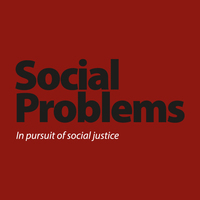




Uploads
Papers by Andrew Jorgenson